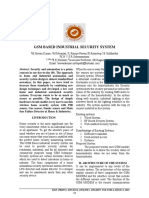0% found this document useful (0 votes)
180 views4 pagesIntroduction to Communication Engineering
The document provides an introduction to communication engineering, describing what it is, examples of areas it involves, and roles of communication engineers. It then compares communication engineering to computer science and digital media, explaining how they relate. It discusses communication engineering as a university major and courses involved. It concludes with a summary of a lab visit in communication engineering labs.
Uploaded by
vanja01nCopyright
© © All Rights Reserved
We take content rights seriously. If you suspect this is your content, claim it here.
Available Formats
Download as PDF, TXT or read online on Scribd
0% found this document useful (0 votes)
180 views4 pagesIntroduction to Communication Engineering
The document provides an introduction to communication engineering, describing what it is, examples of areas it involves, and roles of communication engineers. It then compares communication engineering to computer science and digital media, explaining how they relate. It discusses communication engineering as a university major and courses involved. It concludes with a summary of a lab visit in communication engineering labs.
Uploaded by
vanja01nCopyright
© © All Rights Reserved
We take content rights seriously. If you suspect this is your content, claim it here.
Available Formats
Download as PDF, TXT or read online on Scribd
/ 4


















































































